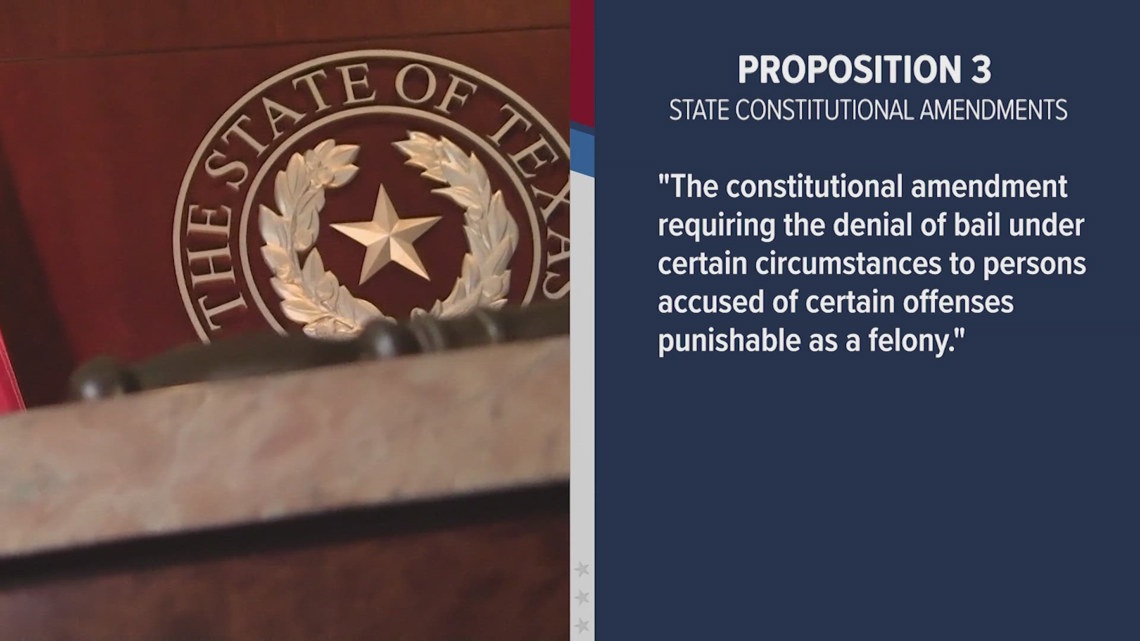Results for Texas Proposition 3: Giving judges more authority to deny bail in violent crimes – KHOU

Report on Texas Proposition 3 and its Implications for Sustainable Development Goals
Introduction: Judicial Authority and Public Safety
A report on Texas Proposition 3, a proposed state constitutional amendment, examines the measure’s intent to grant judges expanded authority to deny bail for individuals accused of specific violent felonies. The debate surrounding this proposition directly engages with several key United Nations Sustainable Development Goals (SDGs), particularly SDG 16 (Peace, Justice and Strong Institutions), by balancing the objectives of public safety against the principles of pretrial liberty and equal access to justice.
Analysis of Arguments in Favor of Proposition 3
Enhancing Community Safety in Line with SDG 11 and SDG 16
Proponents advocate for the proposition as a critical tool for enhancing public safety, a cornerstone of SDG 11 (Sustainable Cities and Communities) and SDG 16.1 (Significantly reduce all forms of violence). The primary arguments include:
- Prevention of Recidivism: Advocates, such as Andy Kahan of Crime Stoppers of Houston, argue the measure is necessary to prevent individuals released on bond from committing further violent acts. Evidence cited includes over 200 murders allegedly committed by defendants released on felony bonds.
- Protecting Vulnerable Populations: The case of Martha Medina, killed by an individual on bond for a separate capital murder charge, is presented as a key example of the system’s failure to protect citizens, undermining the goal of safe and inclusive communities.
- Strengthening Judicial Discretion: The proposition is framed not as a punitive measure but as a preventative one that empowers the judiciary—a key institution under SDG 16—to make case-by-case determinations based on public risk.
Scope of the Proposed Amendment
The measure’s application would be specific and not automatic. For bail to be denied, a prosecutor must present evidence of the defendant’s danger to the community. The offenses covered are limited to a list of serious violent felonies:
- Murder and Capital Murder
- Aggravated Sexual Assault
- Aggravated Kidnapping
- Aggravated Robbery
- Aggravated Assault
- Indecency with a Child
- Human Trafficking
Analysis of Arguments in Opposition to Proposition 3
Concerns for Justice and Equality under SDG 10 and SDG 16
Opponents, including civil rights groups like the Texas Jail Project, contend that the proposition could undermine fundamental legal principles and exacerbate existing inequalities, conflicting with SDG 10 (Reduced Inequalities) and SDG 16.3 (Promote the rule of law and ensure equal access to justice).
- Erosion of Pretrial Liberty: Critics warn that the amendment could shift the legal standard from a presumption of pretrial liberty to a norm of pretrial detention, disproportionately affecting individuals before they are convicted of a crime.
- Strain on Public Institutions: Krish Gunda of the Texas Jail Project predicts a “massive expansion in pretrial detention,” which would increase the burden on already overcrowded county jails, such as in Harris County. This challenges the objective of SDG 16.6 (Develop effective, accountable and transparent institutions).
- Impact on Inequality: An expansion of pretrial detention could deepen societal inequalities, as the inability to secure release often has cascading negative effects on employment, housing, and family stability, disproportionately impacting marginalized communities.
Conclusion and Future Outlook
The passage of Proposition 3 presents a complex challenge in balancing competing SDG targets. While supporters argue it is essential for achieving SDG 16.1 by reducing violence, opponents maintain it would compromise SDG 16.3 by eroding the rule of law and SDG 10 by worsening inequality. Should the proposition be approved by voters, legal experts anticipate court challenges, ensuring that the debate over its impact on justice, safety, and institutional integrity will continue.
1. Which SDGs are addressed or connected to the issues highlighted in the article?
-
SDG 16: Peace, Justice and Strong Institutions
This is the most relevant SDG as the article’s core subject is a proposed change to the legal and judicial system (Proposition 3) concerning bail laws. The debate revolves around strengthening institutions to ensure public safety (a supporter’s view) versus upholding principles of justice like pretrial liberty and preventing overburdened systems (a critic’s view). It directly addresses the balance between peace (community safety) and justice (individual rights).
-
SDG 11: Sustainable Cities and Communities
The article connects to this goal through the theme of community safety. Supporters of Proposition 3 argue it is necessary to keep communities safe from violent offenders. The specific example of a murder occurring in a McDonald’s parking lot highlights the issue of safety in public urban spaces, which is a key component of creating sustainable and safe communities.
-
SDG 5: Gender Equality
This goal is relevant because the article specifies that the proposed amendment would allow judges to deny bail for crimes such as “aggravated sexual assault,” “indecency with a child,” and “human trafficking.” These are forms of violence that disproportionately affect women and girls. The measure, therefore, relates to efforts to eliminate violence against women and children.
2. What specific targets under those SDGs can be identified based on the article’s content?
-
Target 16.1: Significantly reduce all forms of violence and related death rates everywhere.
This target is directly addressed by the supporters of Proposition 3. Their primary argument is that the measure will protect communities by preventing individuals accused of violent crimes from committing further acts of violence while on bail. The statistic cited by Andy Kahan—”Over 200 people who have been murdered by defendants released on felony or PR bonds”—is a direct appeal to the need to reduce violence and related death rates.
-
Target 16.3: Promote the rule of law at the national and international levels and ensure equal access to justice for all.
This target is central to the critics’ argument. They warn that the proposition could erode “pretrial liberty” and make “pretrial detention the norm.” This challenges the principle of being innocent until proven guilty, a cornerstone of the rule of law. Their concern about a “massive expansion in pretrial detention” also touches upon the capacity of the justice system and whether it can provide fair and timely justice for all.
-
Target 11.7: By 2030, provide universal access to safe, inclusive and accessible, green and public spaces…
The article’s mention of Martha Medina being “killed in a McDonald’s parking lot” directly relates to the safety of public spaces. The argument for Proposition 3 is that it will make such community spaces safer by detaining individuals accused of violent crimes, thereby contributing to the goal of safe and accessible public areas for all citizens.
-
Target 5.2: Eliminate all forms of violence against all women and girls in the public and private spheres, including trafficking and sexual, physical and psychological exploitation.
The article explicitly lists “aggravated sexual assault,” “indecency with a child,” and “human trafficking” as offenses for which bail could be denied. These crimes are specific forms of violence against women and children that this target aims to eliminate. The proposition is presented as a tool to help achieve this by preventing accused perpetrators from reoffending.
3. Are there any indicators mentioned or implied in the article that can be used to measure progress towards the identified targets?
-
Indicator related to Target 16.1 (Number of victims of intentional homicide):
The article provides a specific, though anecdotal, indicator: the number of people murdered by defendants out on bond. The statement that “Over 200 people who have been murdered by defendants released on felony or PR bonds” serves as a direct measure of the problem the proposition seeks to address. A reduction in this number would be a key metric for its success.
-
Indicator related to Target 16.3 (Unsentenced detainees as a proportion of overall prison population):
The article implies this indicator through the critics’ concerns. The Texas Jail Project warns of a “massive expansion in pretrial detention” and “overcrowded jails.” This directly points to the proportion of the jail population that is made up of unsentenced detainees. An increase in this proportion following the passage of Proposition 3 would be a measurable outcome reflecting the critics’ predictions.
-
Implied Indicator related to Targets 16.1 and 5.2 (Incidence of specific violent crimes):
The article lists several specific violent felonies, including murder, aggravated sexual assault, and human trafficking. The incidence rates of these particular crimes, especially those committed by individuals on bail, are implied indicators. Supporters would measure success by a decrease in these crimes, while the overall rates would be used to track progress towards reducing violence against the general population and specifically against women and children.
4. Create a table with three columns titled ‘SDGs, Targets and Indicators” to present the findings from analyzing the article.
| SDGs | Targets | Indicators |
|---|---|---|
| SDG 16: Peace, Justice and Strong Institutions | 16.1: Significantly reduce all forms of violence and related death rates everywhere. | Mentioned: Number of people murdered by defendants released on bond (e.g., “Over 200 people… murdered”). Implied: Rate of violent crimes committed by individuals on bail. |
| SDG 16: Peace, Justice and Strong Institutions | 16.3: Promote the rule of law… and ensure equal access to justice for all. | Implied: Unsentenced detainees as a proportion of the overall jail population (referenced by concerns of “massive expansion in pretrial detention”). |
| SDG 11: Sustainable Cities and Communities | 11.7: Provide universal access to safe… and public spaces. | Implied: Rate of violent crime in public spaces (e.g., the murder in a McDonald’s parking lot). |
| SDG 5: Gender Equality | 5.2: Eliminate all forms of violence against all women and girls… including trafficking and sexual… exploitation. | Implied: Incidence rates of specific crimes listed in the proposition, such as aggravated sexual assault, indecency with a child, and human trafficking. |
Source: khou.com
What is Your Reaction?
 Like
0
Like
0
 Dislike
0
Dislike
0
 Love
0
Love
0
 Funny
0
Funny
0
 Angry
0
Angry
0
 Sad
0
Sad
0
 Wow
0
Wow
0



















































.jpg.webp?itok=0ZsAnae9#)
























